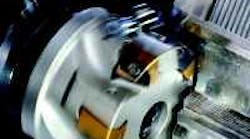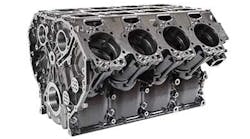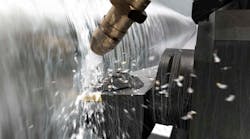Ready for a multitasking mill/turn machine? Think tooling first.
Walter's Xtratec tooling provides quick toolchanges and multiple operations for mill/turn machine users.
The Screwfit line of adapters from Walter combines taper locating with a simultaneous flange fit for easy toolchanges, precision, and rigidity in mill/turn operations.
Sandvik Coromant's Capto system for static turning and rotational milling on mill/turn machines is a face-contact adapter that locates tools using a self-centering tapered polygon.
Kennametal's toolchangeable KM system uses three surface contacts for rigidity in both turning and milling operations on a mill/turn machine.
An internal mechanism overcomes the KM system's interference fit and draws in tools. An internal lock rod strikes the back face of a cavity inside the cutter to release them.
To reduce mill/turn machine toolchanges, Kennametal's multistation tool holds up to four tools that are indexed by rotating the machine's B axis.
In a perfect world, remarks one tooling manufacturer, shops would take a tooling specialist along when shopping for a multi-tasking mill/turn machine. Instead, most shops figure all they need is the machine and fail to realize that partnering it with the right tooling from the start practically guarantees optimized performance.
Mill/turn centers are a combination of milling machine and lathe. And as such, they present special tooling challenges, two of which are rigidity and toolchange time. Tooling and spindle couplings must provide enough rigidity to handle B-axis-spindle work, while also letting shops quickly change tools in an environment where toolchanges often take longer than actual machining operations.
Today's tooling companies approach the rigidity challenge in different ways, but most agree that rigid mill/turn tooling starts with the adapter/spindle coupling. For instance, Walter's Xtratec and Screwfit lines, Sand-vik Coromant's Capto system, and Kennametal's KM system all provide rigidity through special coupling designs.
Walter's Screwfit adaptor combines taper locating with a simultaneous flange fit for easy toolchanges, precision, and rigidity. This two-point-locating system accommodates several different Xtratec tools and adapts to NCT modular-type systems without loss of rigidity. The company also meets the rigidity challenge using special cutter geometries.
"To get around a B-axis spin-dle's lack of rigidity," says Jim Strolberg, vice president of technology at Walter, "shops compromise either the cutting tool or the amount of work. They take shallow cuts and multiple passes or alter the cutter geometry for freer cutting and less force."
His company studies a customer's mill/turn application and designs a tool that applies to a range of operations. Using carbide and coatings, the company develops more-aggressive geometries that produce less cutting forces.
Sandvik's Capto system, on the other hand, is a face-contact adapter that locates tools via a self-centering tapered polygon. Designed for toolchanging along with static turning and rotational milling operations, the system delivers good torque transmission, stability, and balance. Its toolchanging repeatability (tool in and out repositioning) is within 80 millionths.
According to Jim Grimes, product specialist in tooling systems at Sandvik, shops must specify a B-axis spindle with Capto when purchasing a mill/turn machine. Almost every major machine tool builder offers the system as either standard or optional, he adds.
Like Walter, Sandvik also manufactures special tooling for rigid B-axis machining. Those products include 45° turning tools, solid-carbide milling cutters, and wiper inserts.
When B-axis turning (machine spindle locked in the vertical position), shops often add extensions so that the spindle clears obstacles such as chuck jaws, tailstocks, or subspindles. Sandvik's 45° tooling lets shops orientate the spindle at a 45° angle to get it closer to the workpiece without using extensions, which also reduces tool overhang.
Sandvik's solid-carbide milling cutters have, what the company calls, mill/turn geometries. Instead of a negative relief at the cutter's bottom, these four-flute end mills sport two flutes ground neutral and two backed-off from the first two. The backed-off flutes relieve tool pressure, reduce chattering, and prevent tool chipping, while the neutral-ground flutes create a wiper effect for an improved surface finish.
"Basically, only two flutes actively cut when using the bottom of the cutter," explains Grimes. "But all four actively cut when machining radially." With these end mills in their mill/turn machines, shops can cut eccentric diameters, odd shapes, and interrupted cuts that don't lend themselves well to turning.
When using insert cutters such as face mills on a mill/turn machine, Sandvik recommends running wiper-type inserts, such as with its 390 Series insert cutters, to reduce the "scallop" effect of turn milling — turning a diameter with an end mill.
As with Sandvik's Capto system, Kennametal's KM system is well suited for both rotating and static machining on a mill/turn machine. "Most tools on the market suit either a machining center or turning lathe," says Mark Parish, product manager for KM systems at Kennametal. "The steep-taper tooling used on early mill/turn machines is basically a rotating connection. Shops turning with such tooling or applying a static load to it create unstable conditions."
He further explains, "Cutting with a rotating end mill produces little side force, most of which goes straight up the spindle. But when a shop locks out a mill/turn machine's B-axis spindle and turns with it, all the load is radially on the spindle, which causes a bending force. With a traditional coupling, this force actually bends the tool within the spindle because there is only line contact."
The toolchangeable KM system uses three surface contacts for rigidity in both turning and milling operations. It has a short taper and makes contact at the face, the front portion of the taper, and the back of the taper.
Because the KM system incorporates an interference fit, tools are slightly larger than the spindle adapter. For mounting, a mechanism within the spindle overcomes this interference and draws in the tool. To release the tool, an internal hydraulically activated lock rod moves forward and strikes the back face of a cavity inside the cutter.
Shortening toolchange times
Walter, Sandvik, and Kennametal all realize the importance of shorter toolchange times in optimizing mill/turn machine performance. And the key, according to the three companies, is doing more with less tools to eliminate as many toolchanges as possible.
To accomplish this, Walter, for instance, combines several tooling features on one multiple-duty tool "More toolchanging means less production and lower accuracy," comments Strolberg. "With tooling that combines operations, shops simply move the spindle to the part, and the tooling does the rest."
Sandvik also manufactures multipurpose tools for mill/turn machines. Its latest one, called the Mini Turret, is an adapter that holds three different stick tools, so shops can perform three different turning operations without a toolchange.
For example, a shop may load the Mini Turret with roughing, finishing, and grooving tools. Rotating/ indexing the B-axis spindle orientates each tool for cutting.
Mini Turrets not only eliminate toolchanges, but also let shops add more tools to a machine's magazine. In addition, they are well suited for holding redundant tools, such as three roughing tools.
For its multistation tool, Kennametal mounts its KM micro flanges on the end of the tool, which accommodates four different tools. To move to each tool, shops index the B-axis 90°.
A New Standard For Tooling InterfacesMill/turn machines are becoming increasingly popular. However, their toolholding interfaces/adapters tend to vary from one manufacturer to the next. This is why Mitsubishi Materials and other Japanese tool manufacturers (eight carbide cutting tool makers and eight toolholder manufacturers) have established the Interface Committee for Turning-Mills (ICTM). The committee developed a new standard, called the ICTM standard, for HSK toolholder interfaces on multitasking mill/turn machines. ICTM studied the interface mechanism and conducted tests working in cooperation with universities, research organizations, and machine builders to develop the standard. It was adopted based on ISO 12164-1:2001 HSK shank, which specifies a two-face-contact interface mechanism. The new standard focuses on improving turning accuracy by maintaining a high tolerance on the toolholder's drive key and slot. As a result of the standard, shops can use all HSK toolholders on their multitasking mill/turn machines. |













